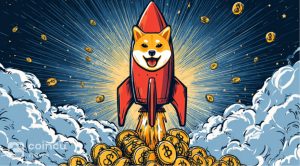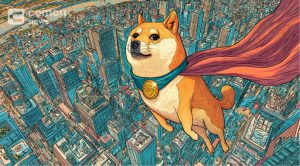Key Points:
- The number of DOGE transactions skyrocketed thanks to the recent introduction of the DRC-20 token standard.
- With DRC-20, it is very cheap to mint new tokens.
- The development has excited Dogecoin community members but has also sparked debate and discussion in the crypto community.
DRC-20 is a token standard that has acquired popularity in the crypto world, especially in relation to Dogecoin (DOGE). With the success of BRC-20, new token standards such as ORC-20,… and now DRC-20 have been developed.

So more specifically, what is DRC-20? What’s so special about this token standard? Let’s find out with Coincu in this article.
What is DRC-20?
The DRC-20 token was released on May 9 and is built on the same technological foundation as the BRC-20 coin.
Digital works, like the BRC-20 standard, are readable on the smallest DOGE unit, known as an Elon. According to the convention, 100,000,000 Elon equals one DOGE.
DRC-20 is a token standard created to address the issues and deficiencies left by BRC-20. With its lightning-fast transaction speed and cheaper costs, it has piqued the interest of both investors and lovers of these token standards.
When a better solution is required, creativity arises to save time. And the DRC-20 is designed to look to do just that.
Inscriptions may include “arbitrary content,” resulting in Dogecoin native digital artifacts that satisfy the criteria of both fungible and non-fungible (NFT) tokens without the need for a sidechain or token person.
At a Bitcoin Ordinals participation, the standard was dubbed Doginals by the Cheems account — a Solana-based meme project that adopted the new standard.
There was no DRC-20 token compiler at the beginning. Enigma, on the other hand, titled some of the future DRC-20 tokens in Cheems, Dogewow, Misu, Pepe, and Meme while releasing minting instructions.

Pros and Cons
Pros
- Enormous investment opportunity: One of the great benefits of the DRC-20’s early stage is the immense investment potential it provides. Being at the forefront of the new token standard helps you to become an expert and lets you delve deep and explore its possibilities.
- Low fee: With DRC-20, minting new tokens is incredibly inexpensive, costing only 0.1 DOGE for each mint. This low fee structure lets you experiment with a range of the tokens without putting your money at risk.
- Confidentiality: By placing the ledger on the chain, the DRC-20 protocol provides the ultimate protection of assets. The current letterhead ledger for BRC-20 tokens, on the other hand, is centrally held by the wallet. It is necessary to distinguish between books and transactions. BRC-20 transactions are carried out on the BTC chain, and the ledger data is saved in the wallet’s database. The wallet creates the account book’s parsing and indexing rules; if the indexing is not done according to the wallet rules, the appropriate written information cannot be located. The DRC-20 ledger will be stored on the ETHF chain, while the transaction will occur on the Dogecoin chain. Even if the wallet is lost, the user may still discover the appropriate inscription; this method of chaining protects the asset’s total safekeeping.
- Fast transaction speed: In order to fulfill its long-term growth objectives, BRC-20 must constantly enhance the DeFi ecosystem, such as by implementing functionalities like stablecoins and oracles. High gas fees, on the other hand, immediately restrict new user engagement. As users mint the standard DRC-20 token on the Dogecoin chain, the number of daily transactions on the Dogecoin chain skyrockets, hitting a record high and overtaking Bitcoin and Litecoin at one time. The BRC-20 token standard’s speculative fever has steadily extended to the Dogecoin chain.
- UTXO model: BTC, LTC, and Dogecoin are all cryptocurrencies that lack smart contract capabilities, enabling developers to construct a variety of programmable tokens and financial products. The DRC-20 token, on the other hand, has a larger user base, and it has its own “meme” feature, which is where the potential lies.
Cons
- Limited infrastructure: DRC-20 is currently in its early phases of development since it is a recently formed standard. This implies that there may not yet be a dedicated explorer, making tracking logs and token transactions difficult.
- No exchange market: There may not be a well-established market for the DRC-20 token at this time. This may make purchasing and selling these tokens difficult since liquidity and accessibility are constrained.
- Hazards of origin and authentication: Due to the lack of an appropriate monitoring method, ensuring the authenticity and validity of DRC-20 minting might be problematic. Without a trusted system, created tokens might pose significant hazards.
How does DRC-20 work?
The Cardinals protocol serves as the foundation for the token standard. The smallest indivisible unit of Dogecoin is designated as “Elon,” with 1 Dogecoin equaling 100,000,000 Elons.
The Cardinals protocol is a numbering scheme for Elon, and each Elon has a serial number that increases in the sequence in which they were mined. These serial numbers are referred to as “Cardinals.” They give each Elon a distinct personality. At the same time, “Inscription” refers to the act of etching text, images, audio, and video data on the elon. Cardinals NFT refers to all of the files carved on Elon, which are now mostly images and words comparable to the Ordinals protocol.
Based on the Cardinals protocol, DRC-20 is a standardized mechanism for homogenous tokens. Apart from BTC and LTC, only Dogecoin can currently perform the UTXO model function. On May 9, the Dogecoin community Dogewow formally announced the deal. DRC-20 intends to investigate the possibility of asset tokenization on the Dogecoin blockchain as a new experiment on the Cardinals protocol. Wallets and protocols are currently significant rule-makers and consensus promoters.
Impact of DRC-20
In an astounding turn of events, Dogecoin’s daily transaction volume has soared to an unprecedented level that exceeds prior records. In only one week, we had a tenfold increase in daily transactions compared to the norm. This increase in activity may be attributed to the recent implementation of a game-changing technology that allows tokens to be created on the Dogecoin network. According to historical statistics, Dogecoin typically sees roughly 20,000 daily transactions. Nevertheless, with the introduction of the DRC-20 token standard on May 9, the network saw an instant increase in activity.

The sudden surge in DRC-20 interest may be traced in part to the marketing and narrative pushed by various Twitter accounts. According to these stories, DRC-20 is the next big thing, similar to the previous token standard BRC-20, with the potential for tokens produced on DRC-20 to generate significant 100x profits. Several people in the crypto world have been drawn to this story. With the launch of DRC-20 and its equivalent ORC-20, developers may now design tokens that run inside the Dogecoin network and use DOGE as network fees. This novel feature not only improves the value proposition of Dogecoin, but also lays the groundwork for the establishment of possible decentralized financial (DeFi) services on the blockchain.
The buzz surrounding DRC-20 stems from the market frenzy around BRC-20 coins, which peaked at $1 billion on May 8. This boom was spurred by fear of missing out (FOMO) on meme coins, which saw a large increase in popularity. Unfortunately, because of the current market decline, the market value of BRC-20 tokens has fallen to $410 million.
Conclusion
The launch of the DRC-20 token standard has undoubtedly increased interest in the Dogecoin blockchain and its possible applications. Finally, the future path of Dogecoin and its ecosystem will be determined by the community’s collective choices and activities, and it will be fascinating to witness how this trend evolves over time.
Despite the increased transaction volume, not everyone is pleased with the DRC-20 token release. Opponents argue that DRC-20 may cause network congestion and deviates from DOGE’s goal of being utilized as a daily currency.
High fees and network congestion are legitimate issues for any blockchain since they may cause the network to become costly and sluggish for daily users, dampening adoption goals.
But, as more people become aware of the advantages of DRC-20 tokens on the Dogecoin network, transaction volume and network activity are expected to rise even more.
DISCLAIMER: The information on this website is provided as general market commentary and does not constitute investment advice. We encourage you to do your own research before investing.
Join us to keep track of news: https://linktr.ee/coincu
Harold
Coincu News






















